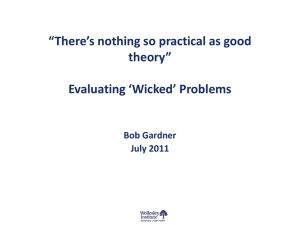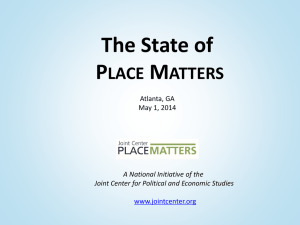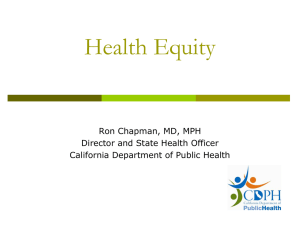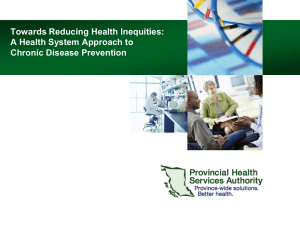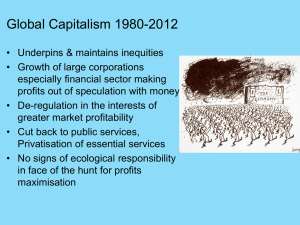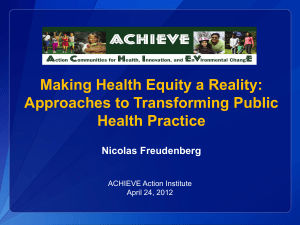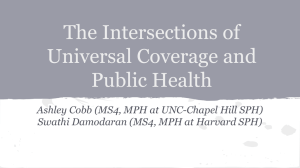Information Sheets - School of Public Health
advertisement
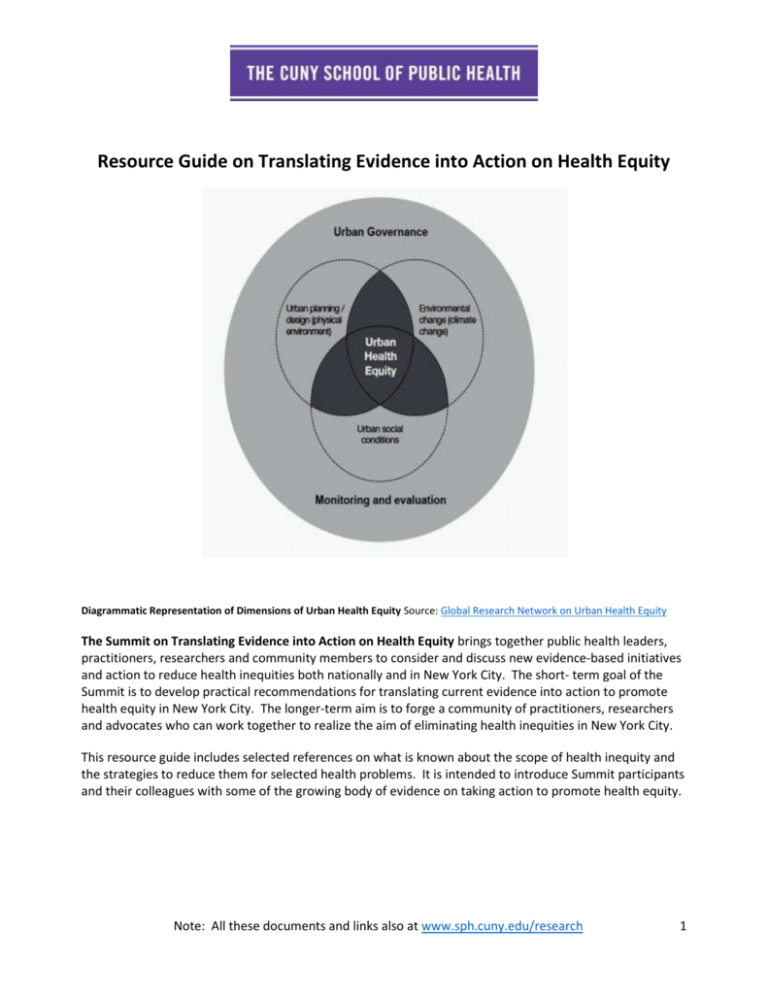
Resource Guide on Translating Evidence into Action on Health Equity Diagrammatic Representation of Dimensions of Urban Health Equity Source: Global Research Network on Urban Health Equity The Summit on Translating Evidence into Action on Health Equity brings together public health leaders, practitioners, researchers and community members to consider and discuss new evidence-based initiatives and action to reduce health inequities both nationally and in New York City. The short- term goal of the Summit is to develop practical recommendations for translating current evidence into action to promote health equity in New York City. The longer-term aim is to forge a community of practitioners, researchers and advocates who can work together to realize the aim of eliminating health inequities in New York City. This resource guide includes selected references on what is known about the scope of health inequity and the strategies to reduce them for selected health problems. It is intended to introduce Summit participants and their colleagues with some of the growing body of evidence on taking action to promote health equity. Note: All these documents and links also at www.sph.cuny.edu/research 1 Suggested Resources on Translating Evidence into Action to Reduce Health Inequities Source: Global Research Network on Urban Health Equity Brownson RC, Fielding JE, Maylahn CM. Evidence-Based Public Health: A Fundamental Concept for Public Health Practice. Annual Review of Public Health 2009; 30(1):175-201.Click here Dankwa-Mullan I, Rhee KB, Stoff DM, et al. Moving toward paradigm-shifting research in health disparities through translational, transformational, and transdisciplinary approaches. Am J Public Health 2010;100:S19S24.Click here Global Research Network on Urban Health Equity. Improving urban health equity through action on the social and environmental determinants of health. University College of London and Rockefeller Foundation, 2010. Koh HK, Oppenheimer SC, Massin-Short SB, Emmons KM, Geller AC, Viswanath K. Translating research evidence into practice to reduce health disparities: A social determinants approach. Am J Public Health 2010;100:S72-S80.Click here Lee H, Fitzpatrick JJ, Baik S-Y. Why isn’t evidence based practice improving health care for minorities in the United States? Applied Nursing Research 2013;26(4):263-268. doi:10.1016/j.apnr.2013.05.004.Click here Minkler M. Linking science and policy through community-based participatory research to study and address health disparities. Am J Public Health 2010;100:S81-S87.Click here Wallerstein N, Duran B. Community-based participatory research contributions to intervention research: The intersection of science and practice to improve health equity. Am J Public Health 2010; 100:S40-S46. Click here World Health Organization. Urban Governance for Reducing Health Inequities. In Hidden Cities. Chapter 6 in Unmasking and Overcoming Health Inequities in Urban Settings, Geneva: WHO, 2010. Click here. Note: All these documents and links also at www.sph.cuny.edu/research 2 Reducing Inequities in Reproductive Health http://www.guttmacher.org/graphics/infographics/Infographic-RHO-740-rev.png Boonstra HD. The impact of government programs on reproductive health disparities: Three case studies. Guttmacher Policy Review 2008;11(3). Click here Brindis CD. A Public Health Success: Understanding Policy Changes Related to Teen Sexual Activity and Pregnancy. Annual Review of Public Health 2006;27(1):277-295. Click here Durand M-A, Carpenter L, Dolan H, Bravo P, Mann M, et al. (2014) Do Interventions Designed to Support Shared Decision-Making Reduce Health Inequalities? A Systematic Review and Meta-Analysis. PLoS ONE 9(4): e94670.Click here Fernández ME, Allen JD, Mistry R, Kahn JA. Integrating Clinical, Community, and Policy Perspectives on Human Papillomavirus Vaccination. Annual Review of Public Health 2010;31(1):235-252. Click here Greene C, Hernandez Jennings M. Reducing Inequities in Sexual Health Outcomes for Young Men of Color. Massachusetts Alliance on Teen Pregnancy, 2014. Click here Planned Parenthood. Priorities for Mayor Bill de Blasio. 2014. Click here Poverty Causes Teen Parenting, Not the Other Way Around. RH Reality Check. Click here Sundaram V, Liu KL, Laraque F. Disparity in maternal mortality in New York City. J Am Med Womens Assoc. 2005;60(1):52-7.Click here Townsend JW. Program strategies for reducing inequities in reproductive health services. Stud Fam Plann. 2010;41(2):139-42.Click here Note: All these documents and links also at www.sph.cuny.edu/research 3 Finding the data to guide efforts to reduce inequities Cook BL, McGuire TG, Zaslavsky AM. Measuring racial/ethnic disparities in health care: methods and practical issues. Health Serv Res. 2012;47(3 Pt2):1232-54.Click here Hosseinpoor AR, Bergen N, Koller T, Prasad A, Schlotheuber A, Valentine N,Lynch J, Vega J. Equity-Oriented Monitoring in the Context of Universal Health Coverage. PLOS Med. 2014 Sep 22;11(9):e1001727. Click here Hughes D, Docto L, Peters J, Lamb AK, Brindis C. Swimming upstream: the challenges and rewards of evaluating efforts to address inequities and reduce health disparities. Eval Program Plann. 2013; 38:112.Click here Martens PJ. The right kind of evidence--integrating, measuring, and making it count in health equity research. J Urban Health. 2012;89(6):925-36. Click here Miao Q, Chen D, Buzzelli M, Aronson KJ. Environmental Equity Research: Review with Focus on Outdoor Air Pollution Research Methods and Analytic Tools. Arch Environ Occup Health. 2014 Jun 27:0. Click here Roos NP, Roos LL, Brownell M, Fuller EL. Enhancing policymakers' understanding of disparities: relevant data from an information-rich environment. Milbank Q.2010 Sep;88(3):382-403.Click here Sridharan S, Tannahill C. Rethinking Evaluations of Health Equity Initiatives: an introduction to the special issue. Eval Program Plann. 2013;36(1):153-6. Click here Welch VA, Petticrew M, O'Neill J, Waters E, Armstrong R, Bhutta ZA, et al. Health equity: Evidence synthesis and knowledge translation methods. Syst Rev. 2013 Jun 22;2:43. Click here WHO | Monitoring health inequality: Illustrations of fundamental concepts. WHO, 2014. Click here Note: All these documents and links also at www.sph.cuny.edu/research 4 Reducing Inequities in Cardiovascular Disease and Cancer High blood pressure ever by neighborhood poverty (age-adjusted) NYC Community Health Survey 2012 APPEAL, Black Women’s Health Imperative, Inter-Tribal Council of Michigan, Inc, Joint Center for Political and Economic Studies, National Council of La Raza, SOPHE. REACH for Health Equity: Racial and Ethnic Approaches to Community Health.; 2014. Click here Bambra C, Joyce KE, Bellis MA, Greatley A, Greengross S, et al. Reducing health inequalities in priority public health conditions: using rapid review to develop proposals for evidence-based policy. J Public Health (Oxf). 2010;32(4):496-505.Click here Heart Disease & Stroke. Baltimore City Health Department. Click here Mt Sinai Medical Center. Preventing heart disease in New York City children and their caregivers. 2014. Click here NYU School of Medicine and CUNY Receive CDC Grant to Establish NYU-CUNY Prevention Research Center Focused on Reducing Cardiovascular Disease Inequities. The Office of Communications & Public Affairs. Click here Sanson-Fisher R, Carey M, Mackenzie L, Hill D, Campbell S, Turner D. Reducing inequities in cancer care: The role of cancer registries. Cancer 2009;115(16):3597-3605. doi:10.1002/cncr.24415. Click here Note: All these documents and links also at www.sph.cuny.edu/research 5 Reducing Inequitable Exposures to Environmental and Occupational Hazards Baron S, Sinclair R, Payne-Sturges D, et al. Partnerships for Environmental and Occupational Justice. 2009. Click here Baron SL, Beard S, Davis LK, Delp L, Forst L, et al. Promoting integrated approaches to reducing health inequities among low-income workers: applying a social ecological framework. Am J Ind Med. 2014;57(5):539-56. Click here Baron SL, Steege AL, Hughes JT Jr, Beard SD. Introduction to a special issue: eliminating health and safety inequities at work. Am J Ind Med. 2014;57(5):493-4. Click here Flegenheimer M. De Blasio Orders a Greener City, Setting Goals for Energy Efficiency of Buildings. The New York Times. Click here Lamb AK, Ervice J, Lorenzen K, Prentice B, White S. Reducing asthma disparities by addressing environmental inequities: a case study of regional asthma management and prevention's advocacy efforts. Fam Community Health. 2011;34 Suppl 1:S54-62. Click here Liebman AK, Network MC, Punnett L, Ruiz V, Justice F, Kidd-Taylor A. The Health of the Low-Income Workforce: Integrating Public Health and Occupational Health Approaches An Issue Paper for Discussion at the Eliminating Health and Safety Disparities at Work Conference, Chicago, Illinois, September 14 and 15, 2011. Click here Ramirez-Andreotta MD, Brusseau ML, Artiola JF, Maier RM, Gandolfi AJ. Environmental Research Translation: Enhancing interactions with communities at contaminated sites. Science of The Total Environment 2014;497-498:651-664. Click here Shire JD, Marsh GM, Talbott EO, Sharma RK. Advances and Current Themes in Occupational Health and Environmental Public Health Surveillance. Annual Review of Public Health 2011;32(1):109-132. Click here Steege AL, Baron SL, Marsh SM, Menendez CC, Myers JR. Examining occupational health and safety disparities using national data: a cause for continuing concern. Am J Ind Med. 2014;57(5):527-38. Click here Note: All these documents and links also at www.sph.cuny.edu/research 6 Reducing Inequitable Exposures to Violence National data from U.S. Bureau of Justice Statistics Backer TE, Guerra NG. Mobilizing communities to implement evidence-based practices in youth violence prevention: the state of the art. Am J Community Psychol. 2011;48(1-2):31-42. Click here Cerdá M, Morenoff JD, Hansen BB, Tessari Hicks KJ, Duque LF, Restrepo A, Diez-Roux AV. Reducing violence by transforming neighborhoods: a natural experiment in Medellín, Colombia. Am J Epidemiol. 2012;175 (10):1045-53. Click here Community Guide Systematic reviews on: Early Childhood Home Visitation , Firearms Laws , Reducing Psychological Harm from Traumatic Events, School-Based Violence Prevention Programs, Therapeutic Foster Care, Youth Transfer to Adult Criminal System. Cook-Craig PG, Millspaugh PH, Recktenwald EA, Kelly NC, Hegge LM, Coker AL, Pletcher TS. From Empower to Green Dot: Successful Strategies and Lessons Learned in Developing Comprehensive Sexual Violence Primary Prevention Programming. Violence Against Women. 2014. Click here Klofas J, Duda J, Schreck C, & Robertson N. SNUG Evaluation. Center for Public Safety Initiatives. 2013. Click here Picard-Fritsche S, Cerniglia L. Testing a Public Health Approach to Gun Violence: An evaluation of Crown Heights Save Our Streets, a replication of the Cure Violence model. Center for Court Innovation. Click here Reuland, M. M., Morabito, M. S., Preston, C., & Cheney, J. (2006). Police-community partnerships to address domestic violence. US Department of Justice, Community Oriented Policing Services. Click here Ward E, Ashley D. The new imperative: reducing adolescent-related violence by building resilient adolescents. J Adolesc Health. 2013;52(Suppl 2):S43-5. Click here World Health Organization, & Injuries and Violence Prevention Department. (2004). The economic dimensions of interpersonal violence. Geneva: Dept. of Injuries and Violence Prevention, World Health Organization. Click here Note: All these documents and links also at www.sph.cuny.edu/research 7 Reducing Inequitable Exposures to HIV and Substance Abuse NYC DOHMH, HIV Epidemiology and Field Services Program - data reported by September 30, 2012; NYC DOHMH population estimates, modified from US Census Bureau intercensal population estimates – updated July 22, 2013 Austin J, Jacobson M. How New York City Reduced Mass Incarceration: A Model for Change? Bennan Center for Justice at NYU Law School, 2013. Click here Campanile C. De Blasio plans treatment instead of jail for “low-level” lawbreakers. New York Post 2014. Click here Coalition of Behavioral Health Agencies. Behavioral Health for New York City’s Future 2014. Click here Cui RR, Lee R, Thirumurthy H, Muessig KE, Tucker JD. Microenterprise development interventions for sexual risk reduction: a systematic review. AIDS Behav. 2013;17(9):2864-77. Click here Freudenberg N. HIV in the epicenter of the epicenter: HIV and drug use among criminal justice populations in New York City, 1980-2007. Subst Use Misuse.2011;46(2-3):159-70. Click here Friedman SR, West BS, Tempalski B, Morton CM, Cleland CM, Des Jarlais DC, Hall HI, Cooper HL. Do metropolitan HIV epidemic histories and programs for people who inject drugs and men who have sex with men predict AIDS incidence and mortality among heterosexuals? Ann Epidemiol. 2014 Apr;24(4):304-11. Click here Hardee K, Gay J, Croce-Galis M, Afari-Dwamena NA. What HIV programs work for adolescent girls? J Acquir Immune Defic Syndr. 2014;66 Suppl 2:S176-85. Click here Rotheram-Borus MJ, Swendeman D, Chovnick G. The Past, Present, and Future of HIV Prevention: Integrating Behavioral, Biomedical, and Structural Intervention Strategies for the Next Generation of HIV Prevention. Annual Review of Clinical Psychology 2009;5(1):143-167. Click here Note: All these documents and links also at www.sph.cuny.edu/research 8 Creating Equitable Responses to Health Emergencies Most Highly Vulnerable Individuals Per Square Mile to All-hazards. Based on NYC DOHMH calculated vulnerability. Blumenshine P, Reingold A, Egerter S, Mockenhaupt R, Braveman P, Marks J. Pandemic Influenza Planning in the United States from a Health Disparities Perspective. Emerging Infectious Diseases 2008;14(5):709715. Click here Carr JL, Sheffield PE, Kinney PL. Preparedness for climate change among local health department officials in New York state: a comparison with national survey results. J Public Health Manag Pract. 2012;18(2):E24-32. Click here Lin L, Savoia E, Agboola F, Viswanath K. What have we learned about communication inequalities during the H1N1 pandemic: a systematic review of the literature. BMC Public Health 2014;14(1):484. oi:10.1186/14712458-14-484. Click here Maja-Schultz T, Swain B. Disabled adults in adult care facilities facing disasters in New York City: an aggregate assessment. Care Manag J.2012;13(2):67-74. Click here Reams MA, Lam NSN, Cale TM, Hinton CM. Applying a community resilience framework to examine household emergency planning and exposure-reducing behavior among residents of Louisiana’s industrial corridor. Journal of emergency management (Weston, Mass.) 2013;11(2):107. Click here Verni C. A hospital system's response to a hurricane offers lessons, including the need for mandatory interfacility drills. Health Aff (Millwood). 2012;31(8):1814-21. Click here Note: All these documents and links also at www.sph.cuny.edu/research 9 Reducing Inequities in Access to Healthy Food Source: Morland et al, 2002 An R. Effectiveness of subsidies in promoting healthy food purchases and consumption: a review of field experiments. Public Health Nutr. 2013;16(7):1215-28. Click here Center for Disease Control and Prevention. Healthy Food Environment, General Food Environment Resources and Strategies for Creating and Maintaining a Healthy Food Environment. Click here Center for the Study of the Presidency and Congress. Health and Medicine Program. SNAP to Health: A Fresh Approach to Strengthening the Supplemental Nutrition Assistance Program, 2012. Click here City of New York. New York City food policy: 2013 food metrics report. 2013. Click here Freudenberg N, Silver M and the Good Food Jobs Research Team. Jobs for a Healthier Diet and a Stronger Economy: Opportunities for Creating New Good Food Jobs in New York City. New York:New York City Food Policy Center at Hunter College, 2013. Click here Gittelsohn J, Rowan M, Gadhoke P. Interventions in small food stores to change the food environment, improve diet, and reduce risk of chronic disease. Prev Chronic Dis. 2012;9:E59. Click here New York City Coalition Against Hunger. Superstorm of Hunger Lingering Shortfalls Expose a Tale of Two Food Cities. 2013. Click here New York City Council. Foodworks: A Vision to Improve NYC’s Food System. 2010. Click here New York City Obesity Task Force. Reversing the Epidemic: The New York City Obesity Task Force Plan to Prevent and Control Obesity, 2012. Click here Public Plate Report Working Group. The Public Plate in New York City: A Guide to Institutional Meals. New York City Food Policy Center at Hunter College, 2014. Click here Note: All these documents and links also at www.sph.cuny.edu/research 10 Reducing Inequities in Mental Health Mental health counseling or treatment by Race/ethnicity (age-adjusted) NYC Community Health Survey 2012 Aidala, A et al. The Frequent User Service Enhancement Initiative: New York City FUSE II. Columbia University Mailman School of Public Health, 2013. Click here Citizen’s Committee for Children of New York. A Prescription for Expanding School-Based Mental Health Services in New York City Public Elementary Schools. 2013. Click here The Fortune Society. An Innovative Program Model for Mental Health Clinic Services for Correctional Reentry Populations: The Fortune Society’s Better Living Center. June 2013. Click here Kazdin AE, Rabbitt SM. (2013). Novel Models for Delivering Mental Health Services and Reducing the Burdens of Mental Illness. Clinical Psychological Science, 1(2), 170–191. Click here Levanon Seligson A. et al. New York/New York III. Supportive Housing Evaluation. A report from the NYC Department of Health and Mental Hygiene in collaboration with the NYC Human Resources Administration and the New York State Office of Mental Health, 2013. Click here Leviton A. Child Health Disparities in New York City. Citizen’s Committee for Children, 2014. Click here U.S. Department of Housing and Urban Development. Linking Housing and Health Care Works for Chronically Homeless Persons. Evidence Matters, 2012. Click here Unutzer J, et al. The Collaborative Care Model: An Approach for Integrating Physical and Mental Health Care in Medicaid Health Homes. Center for Health Care Strategies Inc. May 2013. Click here Note: All these documents and links also at www.sph.cuny.edu/research 11
